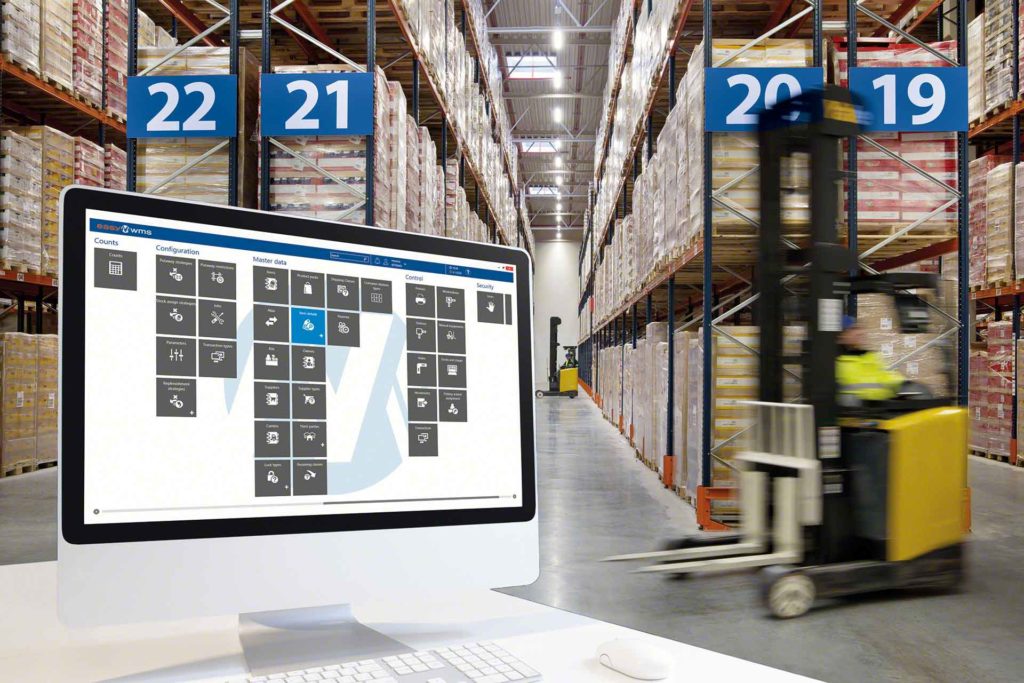
- Warehouse Management System: why you should consider it
- What types of WMSs are in the market
- Warehouse automation: how WMS improves operations
- WMS in the warehouse: how to implement it
- WMS basic functionality
- WMS benefits
- WMS disadvantages
- Popular WMS solutions by developers
- Frequently asked questions
- Conclusions
From the perspective of the management, when considering a warehouse, it’s not about just storage premises. It’s about processes to manage resources efficiently. Frequently, a human makes decisions about where to place orders, how to pick and unload goods, etc. But human touch leads to errors.
Nowadays, the warehousing logistics market is a highly competitive industry. So, companies fight for their clients trying to minimize risks and increase service level quality. A lot of researches show a business should consider warehouse automation. There are a lot of professional solutions helping companies to make warehouse management easier, faster, and more operational. WMS is among such solutions.
Warehouse Management System: why you should consider it
WMS means Warehouse Management System. The solution helps to automate all warehousing processes. In simple words, WMS is software to manage movements in warehouses, from unloading.
If a warehousing provider deals with dispatches by gross, it should consider WMS implementation in its warehouses. Thus, it’s the solution for large companies. Software developers create products for any business needs. It can be simple functionality in-box solutions (documents printing or e-sheets) or sophisticated software adapted for more specific requirements.
WMS is a tool for logistics providers to:
- Enhance HR processes and decrease labor costs.
- Get warehousing stocks reports.
- Increase decision-making speed.
- Minimize production risks.
- Improve client service level.
Warehouse management systems conduct real-time analytics, so you can cost-effectively manage your operations.

WMS systems can connect with the Internet of Things technology. Then, sensors and controllers are attached to goods to collect up-to-date information about their safety, storage-conditions, etc. In this way, all documented data is available in a warehouse management system.
There are 4 types of WMS:
- Entry-level solutions. Such systems work with a limited list of items. Entry-level solutions are appropriate for small and medium-sized businesses that have small levels of turnovers.
- Inbox solutions. Such systems are designed to work with extended lists of items, but small levels of turnovers. Generally, you can’t customize inbox WMS according to your business needs. So, you need to adjust your business processes to a warehouse management system.
- Adaptable solutions. Such warehouse management systems are implemented from scratch, so they are already adapted to your business processes. Large logistics providers and distribution centers use adaptable solutions to speed up their warehousing operations.
- Configurable solutions. Such systems are sophisticated, so they can easily be adjusted to your business requirements during implementation. A configurable WMS is well suited for warehouses with more than 5.000 square meters of storage areas, large ranges of commodities, and big amounts of turnover.
To determine what WMS is more suitable for your warehouse, you should consider requirements analysis before software implementation. Then, your solution provider needs to deliver technical documentation, so you can easily improve your WMS on any stage of business development independently of an IT partner.
Warehouse automation: how WMS improves operations
WMS implementation helps companies fully automate their warehousing processes. Logistics providers get opportunities to:
- Establish accurate processes. After goods arrive at the warehouse, its workers assign a unique barcode to them. Identification data is entered into the WMS system. Now information about the movement of the cargo can be viewed in real-time, which reduces the likelihood of error.
- Increase service level. WMS issues a task to an operator for each type of operation. A warehouse worker can’t process the next step until the software fixes the correct execution of the previous task. The likelihood of damaging or incorrectly completing the cargo is reduced to a minimum, which leads to an increase in the quality of services.
- Reduce time for doing routine operations. WMS tracks goods movements in a warehouse, so operators don’t waste time searching for a product.
- Optimize storage space. WMS systems use algorithms to help you choose the most optimal place for product placement. They take into account dimensions, weight, commodity proximity, and other parameters. Thus, warehouse management systems help you to save space in the warehouse.
Moreover, WMS implementation will increase managers’ productivity.
Warehouse Management System: how to implement it

You should understand the functionality of WMS to choose the best option for your company.
First and foremost, you need to design your warehouse by several layouts, such as loading & unloading, storage, picking, reception, etc.
During implementation, a service provider enters technical information about a warehouse into WMS. It contains storage area, equipment, stuff specifications, etc.
When arriving in a warehouse, all goods are marked with barcodes to track information about their performance. Warehouse stuff gets scanners to forward data to WMS.
To choose storage positions for products, the system analyzes large amounts of information such as storage conditions, commodity neighborhoods, best before dates, etc.
WMS allows you to plan optimum track routes based on real-time information. It helps to avoid inefficient use of warehouse equipment.
Basic WMS functionality:
- Warehouse stocks. WMS tracks inventory in real-time, so you can easily replenish it.
- Warehouse management. You can plan product placing in your warehouse according to commodity neighborhood principles. WMS also significantly increases usable space in your warehouse.
- Reports. WMS independently generates documentation, which later allows managers to track the performance of processes in a warehouse, look for problem areas and ways to optimize activities.
- Selection and packaging. Warehouse employees can knock out lots and series of goods, get information on the assembly and packaging of products.
- Staff. The module allows managers to monitor the performance of each employee in a warehouse, to determine the effectiveness of their work.
The functionality of WMS depends on logistics providers’ requirements. Experience shows WMS increases goods selection accuracy, order placing and processing speed, warehouse capacity.
WMS implementation pros and cons
WMS significantly simplifies routine warehouse operations. However, you should implement it in your business processes correctly and enable staff to handle software features.
Benefits of WMS:
- Reduces the likelihood of errors. When the number of operations in the warehouse grows, employees cannot perform perfectly. Warehouse management systems give staff clear instructions and oversee operations.
- Increases the usable storage space. WMS simulates cargo placement strategies. The systems select the optimal storage location. To do this, they analyze the characteristics of each cargo: weight, dimensions, and so on.
- Reduces the time spent on transactions. The time spent on handling cargo is reduced by an average of 15-20%.
- Controls the turnover. WMS systems monitor inventory balances in real-time. This allows you to buy new consignments without downtime.
- Reduces operating costs. Warehouse management systems can build optimal routes for warehouse equipment. Thus, the load is evenly distributed between the loading equipment.
However, if warehouse workers don’t handle WMS features, you may face challenges.
WMS disadvantages:
- You need the time for your staff to adapt to new business processes. The transition to WMS is a stressful period for warehouse staff. Many employees take a long time to get used to the new rules, and some of them may leave.
- Strict requirements for goods acceptance. Generally, companies work with different suppliers, they have their own established processes. Warehouse management systems put forward stringent requirements for acceptance. If there were a lot of unmarked goods before the WMS implementation, this will slow down your operations.
- Software diversity on the market. Companies don’t always understand which solution is right for them. Therefore, they are forced to rebuild their processes, adapting them to the requirements of a warehouse management system.
Typically, if a company is not satisfied with its integrated solution, it is due to misconfigured processes.
Popular WMS solutions by developers
Check out the list of the most popular WMS among companies.
| Name of the system | Developer |
| G.O.L.D Stock | Symphony EYC |
| Manhattan WMS | Manhattan Associates |
| Qguar WMS | Quantum |
| Oracle WMS | Oracle |
| RedPrairie | Blue Yonder |
Large companies with well-designed business processes often refuse out-of-the-box solutions. They’d better develop a custom WMS that perfectly fits their requirements. Some solution providers develop customized WMS solutions. One of them is CoreTeka. It cooperates with major logistics providers and retailers.
Frequently asked questions
ERP is software to manage a company’s business processes. For example, it can help you to track financial performance, run payroll calculations, organize your clients’ requests, etc. ERP may have built-in warehouse stocks tracking module, but its functionality is limited. WMS is a system developed specifically to the needs of a warehouse.
It depends on a company’s size. Small enterprises should buy a ready-to-use WMS and adjust business processes for it. Large companies develop custom solutions.
It depends on WMS specifications. The cost ranges from $ 2,000 to $ 150,000 for integration.
Conclusions
Warehouse Management System is a solution to automate all routine warehousing operations. Its basic functionality is managing goods acceptance, storage, staff performance, stock levels, etc. WMS capabilities are selected taking into account the company’s business processes.
There are different WMS systems on the market. There are inexpensive boxed solutions for small companies, as well as systems adapted to the needs of large businesses.
The WMS integration helps to establish all warehouse processes, improving the quality of service, reducing the time for order processing, and optimizing the use of warehouse space.




